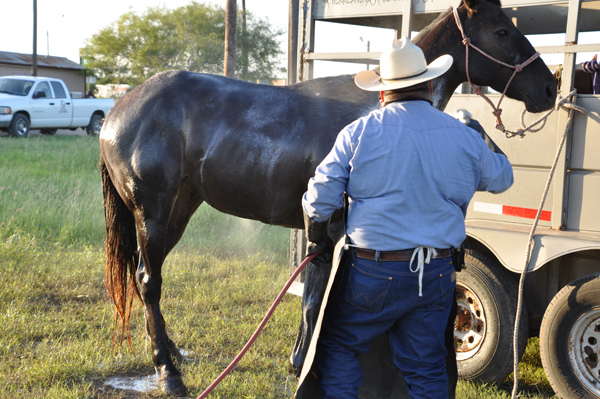- La Feria Community Holds Succesful Business Mixer Event
- Little Nashville to Take Place in Downtown Mercedes
- Lions Basketball Captures District Gold
- La Feria ISD Students Compete in Regional Chess Tournament
- Lions End First Half of 32-4A on a High Note
- La Feria ISD Held Another Successful Parent Conference
- Strong Appearance for Lions at Hidalgo Power Meet
- LFECHS Students Get to Meet Local Actress
- Students Participate in Marine Biology Camp
- Two LFECHS Students Qualify for All-State Band
Cameron County Livestock Under Cattle Fever Tick Quarantine
- Updated: October 31, 2014

Texas Animal Health Commission (TAHC) officials sprayed horses and livestock this past week in an effort to minimize the potential for the spread of fever ticks in Cameron County. Photo: TAHC
AUSTIN – The Texas Animal Health Commission (TAHC) and the United States Department of Agriculture (USDA) have confirmed the presence of cattle fever ticks on Cameron County premises located outside the permanent quarantine zone.
In order to protect the land, premises, and animals from exposure to cattle fever ticks, the TAHC is creating a temporary preventative quarantine area (also commonly known as the “TPQA” or “Blanket Area”) in Cameron County. This TPQA, and its requirements, will become effective October 7, 2014.
The TPQA consists of approximately 223,000 acres. The TPQA will be in effect until all premises within it are released from fever tick quarantines and the area is determined to no longer be at risk of infestation. Within this area, all livestock (cattle & equine) and live or hunted wildlife (such as nilgai antelope and white-tailed deer) that are capable of hosting fever ticks, are subject to movement restrictions, inspections and treatment as prescribed by TAHC fever tick regulations.
Fever ticks, known scientifically as Rhipicephalus (formerly Boophilus) annulatus and R. microplus, are capable of carrying the protozoa, or microscopic parasites, Babesia bovis or B. bigemina. Infected fever ticks inject the protozoan into the bloodstream of cattle as they feed. The Babesia organism attacks and destroys red blood cells, causing acute anemia, high fever, and enlargement of the spleen and liver, ultimately resulting in death for up to 90 percent of susceptible native cattle.
There currently exists a permanent cattle fever tick quarantine zone which ranges from 200 yards to 10 miles wide along the Rio Grande River.
This strip of land extends 500 miles long, through eight South Texas counties, alongside the Rio Grande River from Devils River to the Gulf of Mexico. It was created as a buffer zone to Mexico, where fever ticks are common. This zone allows tick incursions from Mexico to be detected and eliminated quickly, so that cattle in the zone do not potentially spread fever ticks into the interior of the state.
For more information about the temporary preventative quarantine area and movement requirements, call 956-546-6004. For additional information about the Cattle Fever Tick visit, http://www.tahc.texas.gov/animal_health/fevertick/fevertick.html and http://www.aphis.usda.gov/animal_health/animal_diseases/tick/downloads/pest_alert.pdf
Founded in 1893, the Texas Animal Health Commission works to protect the health of all Texas livestock, including: cattle, swine, poultry, sheep, goats, equine animals, and exotic livestock.


